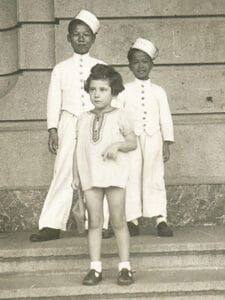In 1939, Irene and Edgar Böhm escaped persecution in Germany, entering Shanghai, one of the only ports in the world that did not require a visa. They were interned in the Hongkew Ghetto. Edgar worked as a waiter.
In 1940, Irene and Edgar’s daughter Dorrit was born.

Image (left): Irene Rothholz (later Boehm) with her family in Germany; her father’s parents are on the right. SJM Collection.
Image (above): Dorrit age 6, on the steps of the Peninsula Hotel in Hong Kong. Behind her, stand two young page boys who worked at the hotel. The photo was taken by Dorrit’s father, Edgar.
In 1939, Irene and Edgar Böhm escaped persecution in Germany, entering Shanghai, one of the only ports in the world that did not require a visa. They were interned in the Hongkew Ghetto. Edgar worked as a waiter.
In 1940, Irene and Edgar’s daughter Dorrit was born.

Image (left): Irene Rothholz (later Boehm) with her family in Germany; her father’s parents are on the right. SJM Collection.
Image (above): Dorrit age 6, on the steps of the Peninsula Hotel in Hong Kong. Behind her, stand two young page boys who worked at the hotel. The photo was taken by Dorrit’s father, Edgar.


